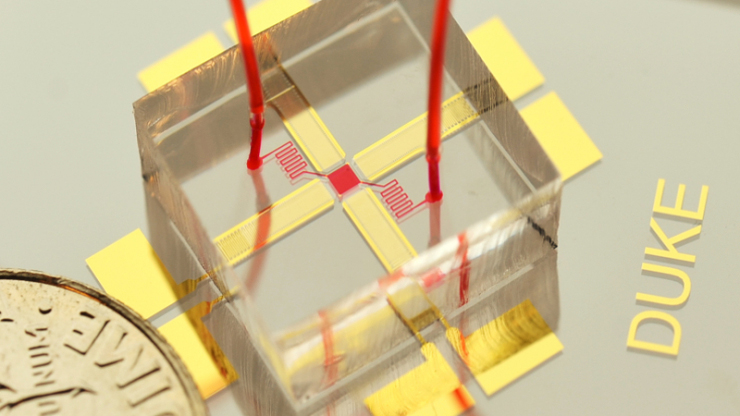Researchers at Duke University created an acoustic tweezer system that can precisely manipulate cells and particles. The device can be used to study the interactions between cells, for instance by precisely selecting two cells in a sample and bringing them together gently to study the adhesion force between them. This could be useful in discovering the affinity between cancer cells and other cell types, as a proxy for studying metastasis, or the interaction of immune cells with cancer cells.
Acoustic tweezer technology involves using sound waves to precisely move, pinch, separate or suspend cell or particles, typically within a microfluidic system. The Duke researchers hope that their version of this technology could assist with cancer research and precision therapy for cancer patients. Acoustic tweezers have significant potential in manipulating cells in very precise ways. This newest inception is incredibly precise and gentle, leading the researchers to call it the Harmonic Acoustics for Non-contact, Dynamic, Selective particle manipulation platform (HANDS platform).
 The new sound-based technology can pair individual cells together and pull them back apart hundreds of times over.
The new sound-based technology can pair individual cells together and pull them back apart hundreds of times over.
“The separation of paired particles or cells has been a major target in the field of acoustic manipulation for many years,” said Tony Jun Huang, a researcher involved in the study. “Our HANDS platform is the first method of separating paired objects, which provides a way into cell-cell interaction studies that are needed extensively in biophysics studies and drug discovery.”
The device consists of four sound-emitting transducers, one of which sits on each side of a square fluid-filled central chamber. The transducers are more sophisticated than those used in some previous acoustic tweezer technologies, and can produce complex standing waves rather than the usual static waves. Each transducer forms a pair with the one opposite, and each creates a slightly different type of sound wave pattern, with one in each pair emitting vertical waves and the other horizontal waves. The way these waves interact allows the researchers to perform complicated acoustic manipulations within the chamber.
 The new sound-based technology can also form an ordered, single-layer crystalline structure out of a group of particles or cells.
The new sound-based technology can also form an ordered, single-layer crystalline structure out of a group of particles or cells.
“I simulated how these waves might combine to manipulate the particles in the chamber and then ran experiments to see actual results,” said Shujie Yang, another researcher involved in the study. “It took a long time and many trials, but finally the simulations became good enough to start matching the results. And once the simulations were accurate, I could begin predicting new abilities.”
The technology will allow researchers to study the interactions between cells more easily, giving them more precise control. “I am thrilled about the capabilities of this platform, which is as gentle as a mother’s hands,” said Luke Lee, another of the developers of the new tweezers.. “Gentle and sensitive mother’s hands allow us to establish the foundation of quantitative cell biology and translational precision medicine. For example, we can study T-cell interactions with cancer cells in a high-throughput manner and obtain precision cell-cell interaction forces. This could help doctors find the most effective and specific cell therapy for patients as personalized precision medicine.”
Study in Nature Materials: Harmonic acoustics for dynamic and selective particle manipulation
Via: Duke University
